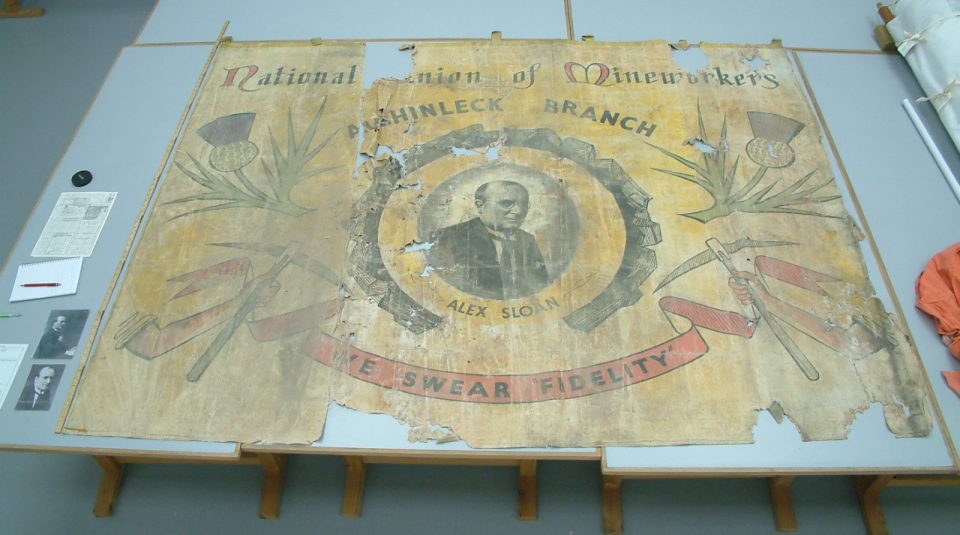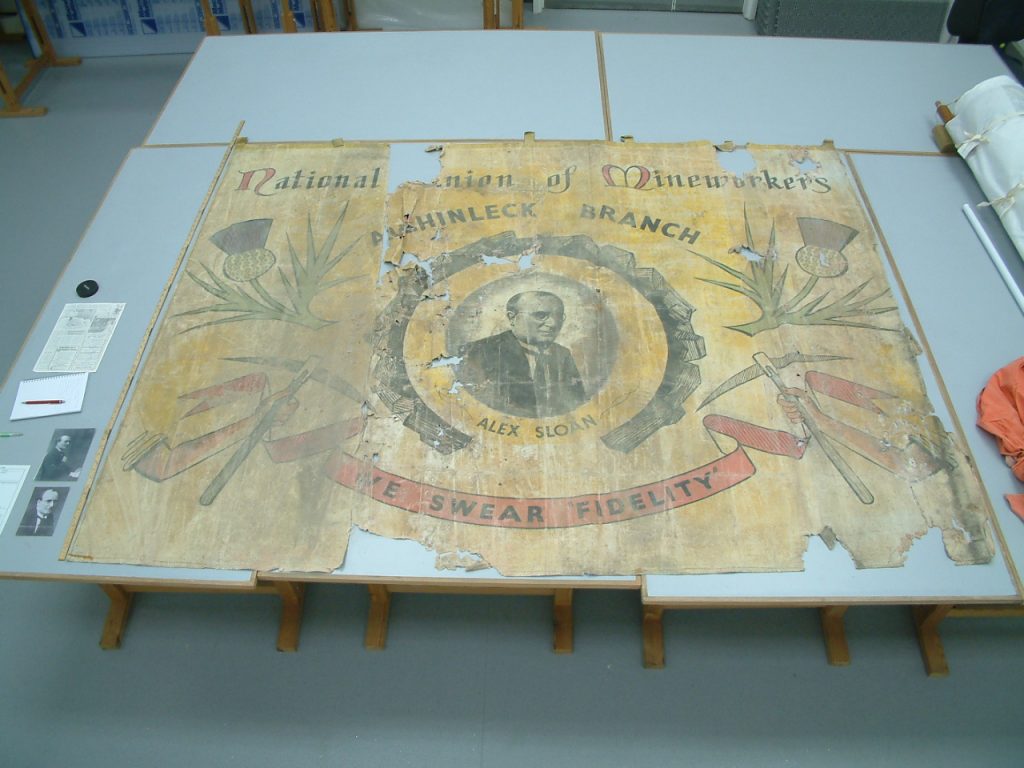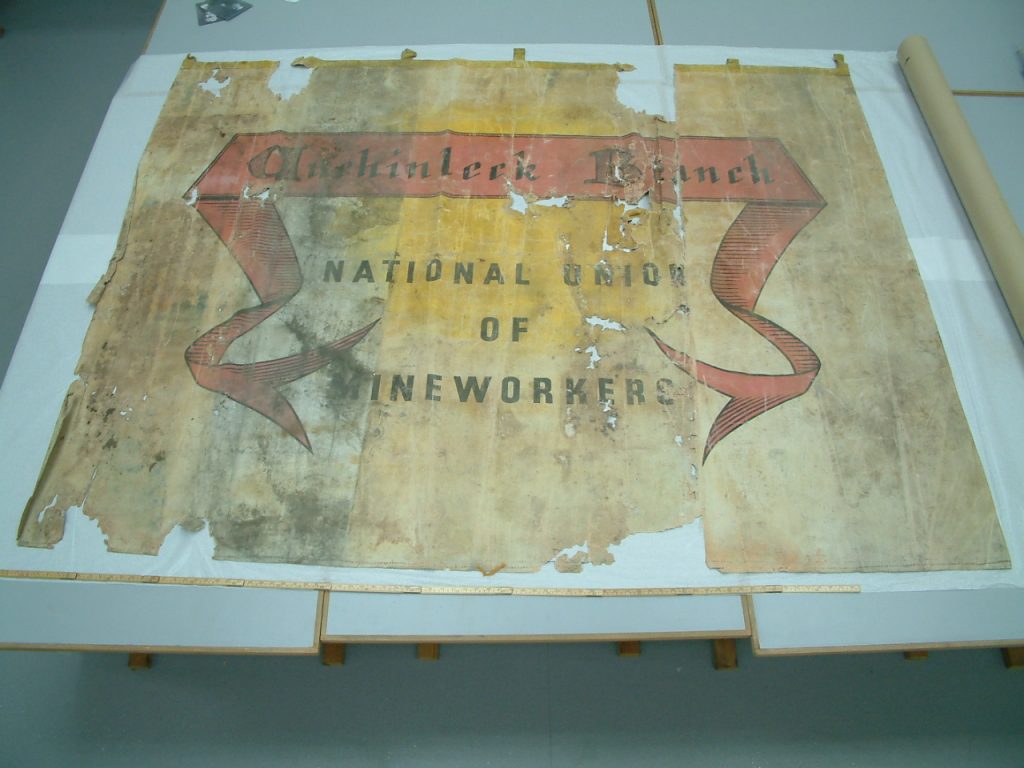
Jenny van Enckevort, Conservation Manager at People’s History Museum, discussing a banner she is currently working on.
To mark Armistice Day I would like to reflect on the tragic family story behind a banner I am currently working on in The Conservation Studio at the People’s History Museum (PHM).
This is a National Union of Mineworkers (NUM) Achinleck Branch banner now belonging to the granddaughter of Alexander Sloan who is featured in the portrait on the banner. Alexander or ‘Sanny’ and he was known, was born in 1879, one of 12 children. They were part of a mining community in South Ayrshire, Scotland. The children started work at 12 years old, the boys in the mine and the girl as a farm servant. While still a child Sanny was involved in a pit accident and lost the sight in one eye.
Five of the sons fought in World War I and four were killed; Robert the baby of the family died first aged just 19 on the 22 April 1915 at the Second Battle of Ypres. He had emigrated to Canada in 1913 so was fighting for the Canadian Expedition Force. William had also moved to Canada, he described himself as a miner when he joined the Canadian Expedition Force. He served as a sapper for the 2nd Canadian Tunnelling Company, he died on the 28 June 1916 aged 23. Sanny was a miner and not conscripted; he was also a pacifist.
Thomas and Charles were also in Canada but moved back to Scotland to join up in 1914. Thomas worked briefly at Woodmuir Colliery near Bathgate before joining the Scots Guards. He was killed aged 28 on the 15 September 1916, leaving behind a wife Mary Anne and young son. Mary Anne later remarried but still had Thomas’s letters in her handbag when she passed away as an old lady.
The telegrams telling their mother the heartbreaking news that both William and Thomas were dead arrived on the same day. Sanny wrote to the war office requesting that his brother Donald, who was fighting on the front line, be moved to a slightly safer posting, the response came back saying that it was an honour to die for your country. Donald died on the 1 January 1917 aged 33 he fought with the Royal Highlanders Black Watch. He was married with four children and was a professional footballer with Everton and Liverpool football clubs.
Likely as a result of these experiences Sanny was a pacifist throughout his adult life and became dedicated serving his community, he got involved in campaigns for safer working conditions in the mines and was known for assisting workers with claims for compensation. As a councillor, serving for 25 years, he fought for improvements to housing and education and as a Labour MP, for six years, he made his voice heard with 640 interjections in parliament during that time.


The NUM Achinleck Branch banner circa 1940 is reportedly designed and painted by Richard Strain a Pithead Worker at Barony Coal Mine who was noted as having a flair for sign writing. It is made from a canvas cloth and is painted on both sides with oil medium. The face side features a portrait of Alexander Sloan surrounded by a wreath of coal, it also depicts a pair of thistles and arms with pick axes (the tools of the trade). Above the images is the title, ‘National Union of Mineworkers Achinleck Branch’ and below a ribbon scroll bearing the motto ‘We swear fidelity’. The reverse side features a ribbon scroll repeating the branch name and ‘National Union of Mineworkers’ beneath. After active use the banner was kept in Achinleck Town Hall where it lay undisturbed until the 1980s before the building was demolished, it was then moved to a garden shed before returning to Sanny Sloan’s family.
The banner came to The Conservation Studio at PHM in January 2018 with conservation beginning in summer 2018. The condition is very poor as a result of its previous storage conditions; the canvas has been weakened leading to structural tears and losses. The surface is covered in soiling, mould deposits and waterborne staining. The paint is poorly adhered to the surface in many areas making it difficult to handle and even clean safely without enduring further losses. The treatment proposal includes cleaning to remove soiling and stains, where possible, working methodically in 10cm by 10cm squares. This will be followed by consolidation of the loose paint fragments using a conservation grade adhesive. The banner will then be fully supported with a transparent layer on the reverse side and the areas of loss will be filled with a sympathetic fabric, coloured to match the original.
The conservation is ongoing at time of writing (November 2018). If you visit the museum you may be able to see the banner from the viewing window in Main Gallery Two.